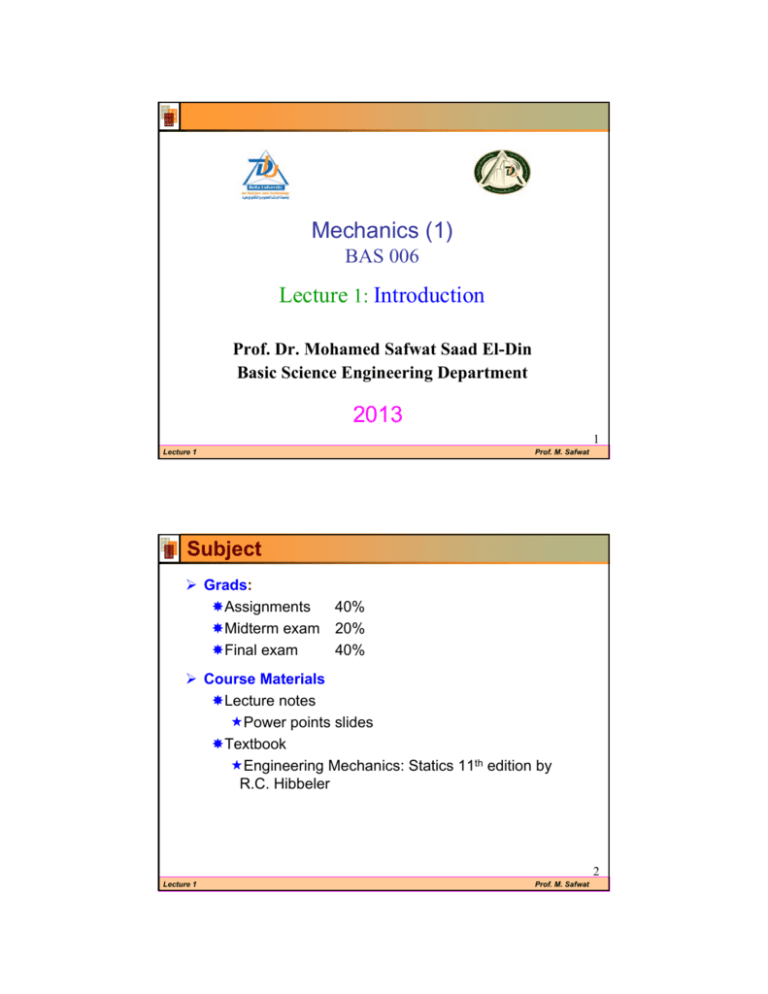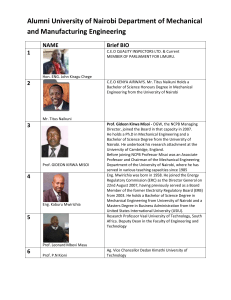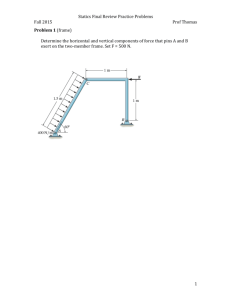Mechanics (1) Lecture 1: Introduction 2013
advertisement

Mechanics (1) BAS 006 Lecture 1: Introduction Prof. Dr. Mohamed Safwat Saad El-Din Basic Science Engineering Department 2013 1 Eng. Malek Abuwarda Prof. M. Safwat Lecture 1 Subject Grads: Assignments Midterm exam Final exam 40% 20% 40% Course Materials Lecture notes Power points slides Textbook Engineering Mechanics: Statics 11th edition by R.C. Hibbeler 2 Lecture 1 Eng. Malek Abuwarda Prof. M. Safwat Instructional Objectives After completing the course, The student should be able to: Analyze forces and find out the resultant forces in two and three dimension Differentiate between various type of supports and draw free-body-diagram Compute the reaction force, internal forces and bending moment at a specific point on a simple structure (beam, frame, truss) Obtain centre of mass and centroid for deferent engineering shapes & moment of inertia for deferent sections. Types of friction, Characteristics of Dry Friction, Theory of Dry Friction, Impending Motion, Motion 3 Lecture 1 Eng. Malek Abuwarda Prof. M. Safwat Course Outline: Introduction to Statics Force System: • Two-dimensional force systems. • Three-dimensional force systems. Equilibriums: • Equilibrium in two dimensions. • Equilibrium in three dimensions. Structural Analysis: Trusses Truss Analysis The Method of Joints Zero - Force Members The Method of Sections Beams 4 Lecture 1 Eng. Malek Abuwarda Prof. M. Safwat Course Outline (cont.) Distributed Forces: Centers of Mass and Centroids Beams-External Effects Beams-Internal effects Area Moments of Inertia Friction: • Introduction • Types of Friction 5 Eng. Malek Abuwarda Prof. M. Safwat Lecture 1 Introduction to Mechanics What is mechanics? Physical science deals with the state of rest or motion of bodies under the action of force Mechanics Statics Dynamics Kinematics Kinatics Why we study mechanics? This science form the groundwork for further studies in the design and analysis of structures 6 Lecture 1 Eng. Malek Abuwarda Prof. M. Safwat Basic Terms Essential basic terms to be understood Particle: a body of negligible dimension Rigid body: the relative movement between its parts are negligible Mass: the amount of matter in a body Weight: the force with which a body is attracted toward the centre of the Earth Force: the action of one body on another whether it’s a push or a pull force Length: applied to the linear dimension of a strait line or curved line Area: the two dimensional size of shape or surface Volume: the three dimensional size of the space occupied by substance 7 Lecture 1 Eng. Malek Abuwarda Prof. M. Safwat Units of Measurement Four fundamental quantities in mechanics: • Mass (M) • Length (L) • Time (T) • Force (F) = Mass x Acceleration = M x (L / T2) Two different systems of units: • U.S. Customary or British System of Units (FPS) • International System of Units or Metric Units (SI) 8 Lecture 1 Eng. Malek Abuwarda Prof. M. Safwat The four fundamental quantities in the two system: SI Units US Units Quantity Unit Symbol Unit Symbol Mass kilogram kg slug slug Length meter m foot ft Time second s second sec Force newton N pound lb The standard value of g (gravitational acceleration) SI units g = 9.806 m/s2 FPS units g = 32.174 ft/sec2 9 Lecture 1 Eng. Malek Abuwarda Prof. M. Safwat







